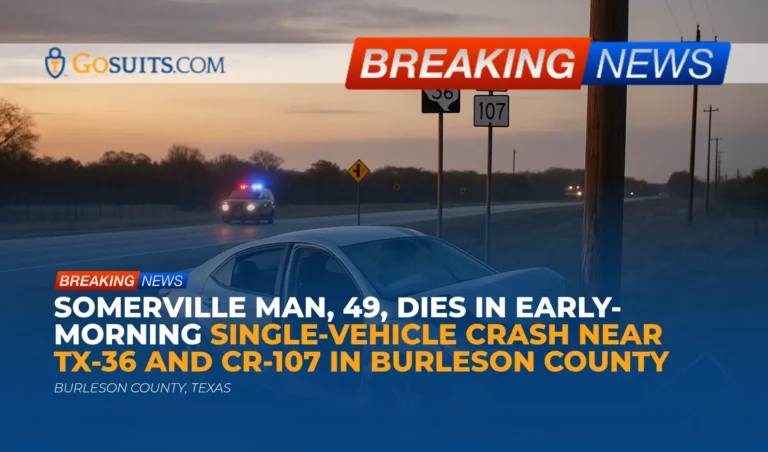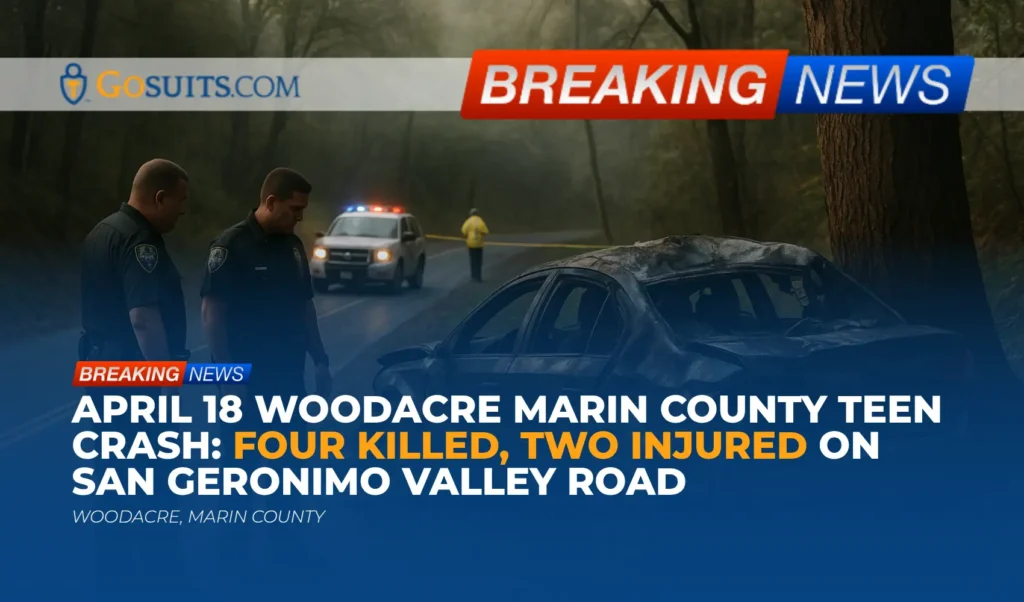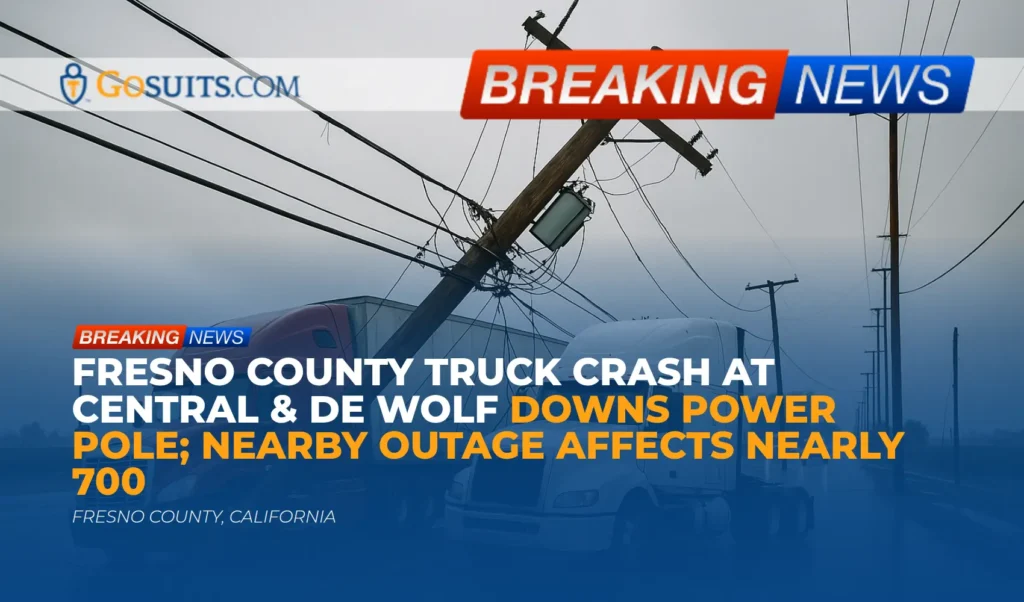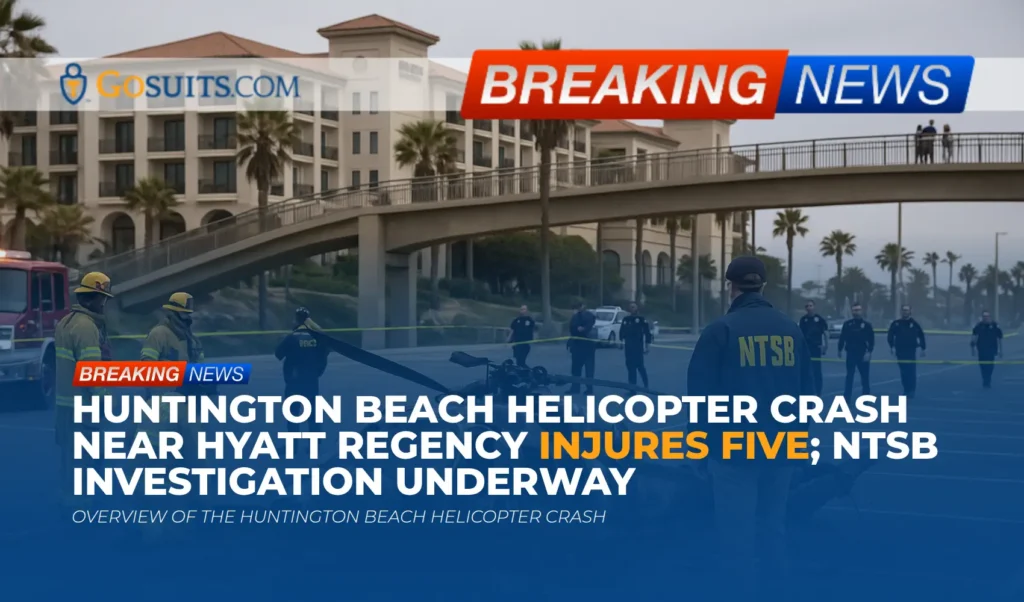- Summary of the reported crash
- Location, timing, and responding agencies
- Understanding single-vehicle fatal crashes in Texas
- Why cause matters in a single-vehicle crash and potential civil liability
- Key records to request and who to contact
- Practical steps people often take after a fatal crash
- Insurance issues that commonly arise
- When roads or vehicles may be part of the problem
- Time limits and formal notice requirements in Texas
- How critical evidence is preserved
- Community safety considerations and prevention
- Commentary from Gosuits Burleson County, Texas Personal Injury Attorney
- Why timely action matters after a fatal crash
Summary of the reported crash
Local news reports indicate that a fatal single-vehicle crash occurred in the early morning hours in Burleson County, Texas. According to publicly reported information, at around 5 a.m. on a Sunday, a vehicle traveling near the intersection of CR-107 and State Highway 36 left the roadway, struck a sign and then a wooden pole, and the driver was ejected. A 49-year-old man from Somerville was pronounced dead at the scene. Agencies that responded reportedly included the Caldwell Fire and Rescue Department, the Texas Department of Public Safety, the Burleson County Sheriff’s Office, and the Caldwell Police Department.
Any loss of life on our roads is heartbreaking. Our thoughts are with the family, friends, and community members affected. As is common in serious collision investigations, state and local agencies will typically analyze physical evidence, interview witnesses, and review any available roadway or vehicle data to understand how and why this occurred.
Location, timing, and responding agencies
Where and when
Based on the reporting, the incident took place around 5 a.m. near the intersection of CR-107 and TX-36 in Burleson County. Dawn or pre-dawn hours can be challenging for visibility and fatigue, but specific contributing factors are not publicly confirmed at this time.
Who responded
Multiple agencies responded, including local fire and police, the county sheriff’s office, and the Texas Department of Public Safety. In Texas, the Department of Public Safety often leads or assists in crash investigations on state highways, while local agencies support scene safety, medical response, and traffic control.
Understanding single-vehicle fatal crashes in Texas
Single-vehicle crashes, while sometimes assumed to involve only driver error, can stem from many converging factors. National data show that single-vehicle crashes account for more than half of fatal crashes in recent years. The National Highway Traffic Safety Administration has reported that in 2021, over half of fatal crashes nationwide were single-vehicle events, underscoring how dangerous roadway departures and fixed-object crashes can be. See NHTSA’s overview of 2021 crash trends for context: NHTSA Traffic Safety Facts Overview.
Roadway departure and fixed-object collisions
When a vehicle departs the roadway, fixed objects near the travel lane such as signs, poles, or trees can become deadly. The Federal Highway Administration’s safety guidance discusses the importance of roadside design and maintaining a “clear zone” to reduce the likelihood that a departing vehicle hits a fixed object. For background on the clear zone concept, see the FHWA Office of Safety: FHWA Clear Zones.
Ejection risks and seat belts
Ejection is strongly associated with severe and fatal outcomes. While investigators will determine the circumstances in any specific crash, national safety research shows seat belts are one of the most effective ways to prevent total ejection and reduce fatal injury risk. NHTSA notes that seat belts can reduce the risk of fatal injury to front-seat passenger car occupants by about 45 percent and are highly effective at preventing total ejection. For an accessible summary, see NHTSA’s seat belt safety page: NHTSA Seat Belts.
It is important not to draw conclusions about belt use from news snippets alone. Ejection can occur in unusually severe crashes and under other circumstances. The official crash report and any investigator findings provide a more complete picture.
Why cause matters in a single-vehicle crash and potential civil liability
When a crash involves one vehicle, the law still considers all potential contributing factors. Depending on the evidence, responsible parties may include more than the driver. Examples include:
- Roadway conditions or design: Missing or obscured signage, inadequate shoulder, poor drainage, unsafe slopes, or hazardous fixed objects too close to the travel lane may contribute to loss of control. Agencies responsible for design or maintenance can sometimes face civil claims, subject to strict notice rules and immunities under Texas law. See the Texas Tort Claims Act framework: Tex. Civ. Prac. & Rem. Code ch. 101.
- Vehicle defects or maintenance: Steering, suspension, tire failures, airbag or restraint malfunctions, or defective components can contribute to a crash or worsen outcomes. Event data recorders, recalls, and inspection records can matter. See NHTSA’s page on event data recorders for general background: NHTSA Vehicle EDR.
- Third-party involvement: A vehicle that cuts off or forces another off the road may leave the scene. In those cases, a thorough search for witnesses, cameras, and physical evidence can be vital to confirm whether another party contributed.
- Other factors: Wildlife, unexpected debris, weather, lighting conditions, and medical events may all play a role. Evidence collection and expert analysis help distinguish among these possibilities.
For families, understanding the “why” has both emotional and legal significance. The wrongful death and survival statutes in Texas allow certain relatives and estates to pursue civil claims when someone’s death results from a wrongful act or negligence. See Texas Civil Practice and Remedies Code chapter 71: Tex. Civ. Prac. & Rem. Code ch. 71.
Key records to request and who to contact
Accessing official records helps answer questions and preserves rights. Below are common records and how they are typically obtained in Texas. Specific agencies will vary by case and county.
Official Texas crash report (CR-3)
- What it is: The investigating officer’s report with diagrams, contributing factors, and involved parties.
- Where to request: The Texas Department of Transportation maintains the online system for purchasing crash reports. Reports are generally available to parties with a qualifying interest under Texas law. See TxDOT’s Crash Report Purchase system: TxDOT CRIS Purchase.
Texas Department of Public Safety investigative materials
- What it is: Supplemental narratives, photos, and measurements sometimes exist beyond the CR-3.
- How to request: Some materials may be available via a public information request to the investigating agency, subject to exceptions. The Texas Attorney General provides guidance on making a Public Information Act request: Texas AG PIA Guidance.

911 audio and dispatch records
- What it is: Audio of emergency calls and computer-aided dispatch logs that can clarify timing and response.
- How to request: Submit a public information request to the dispatching agency or regional emergency communications authority, following the Attorney General’s PIA guidance linked above.
Autopsy, inquest, and toxicology
- What it is: In Texas, deaths from unnatural causes typically trigger an inquest conducted by a county medical examiner where available, or by a Justice of the Peace in most counties without a medical examiner. Autopsies and toxicology may be ordered as part of that process. See Texas Code of Criminal Procedure chapter 49 for inquests and medical examiners: Tex. Code Crim. Proc. ch. 49.
- Who to call: Families can contact the Burleson County Justice of the Peace office that handled the inquest or the agency the JP designated for forensic services. If a regional medical examiner performed the autopsy, that office typically provides instructions for requesting reports to next of kin.
Death certificate
- What it is: An official vital record listing the cause and manner of death as determined through the inquest process.
- Where to request: The Texas Department of State Health Services Vital Statistics office handles death certificates. Application instructions are here: DSHS Death Certificate Application.
Vehicle data and storage
- What it is: The vehicle itself, airbag control module or event data recorder, and any personal property inside.
- Who to call: The investigating agency can identify the wrecker service or storage lot. Before authorizing dismantling or salvage, consider preserving the vehicle in its post-crash condition for inspection.
Practical steps people often take after a fatal crash
In the days and weeks after a fatal collision, it can feel overwhelming to balance grief and logistics. Many families find it helpful to proceed in a measured way that preserves important information while respecting the immediate needs of mourning and memorial. Common steps include:
- Secure essential records: Obtain the official crash report through TxDOT and ask the investigating agency how to request photos, diagrams, and supplemental narratives.
- Identify the inquest authority: Inquire with the county about which Justice of the Peace or medical examiner handled the inquest and how to request autopsy and toxicology, if performed. Reference Texas Code of Criminal Procedure chapter 49 for process context: Inquests and Medical Examiners.
- Preserve the vehicle: Ask that the vehicle remain secured and unrepaired until an inspection can occur. Vehicle evidence often answers critical questions.
- Document the human story: Keep a journal of events, interactions, and expenses. Save receipts for travel, memorial services, and other costs. These details can be hard to reconstruct later.
- Locate potential witnesses and footage: Note nearby businesses or residences that may have cameras. Early outreach can prevent loss of video that is often overwritten within days.
- Be cautious with insurers: Before making recorded statements or signing forms for any insurer, consider speaking with a seasoned injury attorney. Statements given to insurance adjusters can be used later in ways that affect civil claims.
Insurance issues that commonly arise
Every crash presents a unique insurance landscape. The following concepts often arise in single-vehicle fatal collisions in Texas:
- Liability coverage: If an employer, manufacturer, roadway entity, or another driver contributed to the crash, their liability coverage may be implicated. Sorting out responsibility takes evidence and analysis.
- PIP and medical payments benefits: Texas policies sometimes include Personal Injury Protection or MedPay, which can provide limited benefits regardless of fault. Coverage terms and beneficiaries vary by policy.
- Uninsured or underinsured motorist coverage: If evidence shows another vehicle’s actions caused the crash but that vehicle is unknown or uninsured, UM or UIM coverage may be relevant. Corroborating evidence is often necessary.
- Life insurance, accidental death, and employer benefits: Separate from auto coverage, there may be life or accidental death benefits, or employment-related benefits. Policy terms control.
- Recorded statements and releases: Insurance companies sometimes seek statements or push for early releases. Consulting an attorney first helps ensure rights are protected and that no one unknowingly limits potential claims. What is said to an insurer can be used later.
When roads or vehicles may be part of the problem
Road design and maintenance aim to minimize the consequences of a mistake or unexpected event. If a vehicle leaves the roadway, a forgiving roadside and adequate clear zone reduce the chance of hitting hazardous fixed objects. The Federal Highway Administration provides background on these countermeasures: FHWA Clear Zones.
Potential roadway issues include missing or obscured warning signs, inadequate delineation at curves, compromised shoulders or edge drop-offs, poor drainage that contributes to hydroplaning, or encroachments by fixed objects within the clear zone. When crashes occur at or near state routes such as TX-36, state and local responsibilities can overlap. Determining who is responsible for a particular feature often requires maintenance records, project plans, and communication between agencies.
Vehicle-related issues can also matter. Tire failures, steering or suspension problems, brake defects, and restraint system performance can influence both crash occurrence and injury severity. Modern vehicles often store pre-crash data such as speed, throttle, and braking for a short interval, which can help reconstruct events. See NHTSA’s information on event data recorders: NHTSA Vehicle EDR. Proper access and interpretation usually require specialized tools, and preserving the vehicle is critical.
Time limits and formal notice requirements in Texas
Texas law sets deadlines for civil claims and separate notice requirements for claims against governmental entities. These rules are strict, and missing them can foreclose claims.
- General limitations period: Texas generally allows two years from the date of the incident to bring wrongful death and survival claims. See Tex. Civ. Prac. & Rem. Code § 16.003 and chapter 71. Specific facts can affect timing, and different rules can apply in certain contexts.
- Claims involving government entities: Texas’s Tort Claims Act requires that claimants provide notice of a claim within a defined period, often within six months, and some local charters require even earlier notice. See Tex. Civ. Prac. & Rem. Code ch. 101.
- Preservation letters: Early written requests to preserve documents, video, and physical evidence can help prevent loss. While not a substitute for legal deadlines, timely preservation demands can be important.
How critical evidence is preserved
Evidence can fade within days. Taking organized steps to preserve and collect it helps families and investigators understand what happened. Key categories include:
- Scene documentation: Photographs of the crash site, vehicle resting positions, tire marks, debris fields, and damage to roadside objects. When official scene photos are unavailable or limited, prompt independent documentation can be helpful.
- Vehicle inspection and downloads: Secure storage of the vehicle to prevent repairs or destruction, followed by a professional inspection and, if feasible, an event data recorder download.
- Witness identification: Canvas the area for drivers or nearby residents who saw or heard the crash, or whose security cameras might have captured the moments before or after the collision.
- Public records and maintenance logs: Requests for roadway maintenance records, sign installation logs, and any prior crash history at or near the location can shed light on systemic hazards.
- Medical and inquest records: Autopsy and toxicology reports, as available, help clarify injury mechanisms and medical factors without relying on speculation. See Texas Code of Criminal Procedure chapter 49 for inquest process: Inquests and Autopsies.

Community safety considerations and prevention
One goal of thorough crash review is to identify changes that make future tragedies less likely. Agencies often examine the roadway environment, signage, and clear zone, and consider whether enhancements are warranted. The FHWA promotes countermeasures that reduce the severity of roadway departures, including shoulder improvements, rumble strips, better delineation, and removing or shielding hazardous fixed objects. For background, see FHWA safety resources: FHWA Office of Safety.
At the community level, routine reporting of missing or damaged signs, vegetation that blocks sightlines, or hazardous shoulders helps road authorities respond more quickly. On the vehicle side, timely maintenance and tire care, checking for recalls, and ensuring seat belt use remain important layers of protection. NHTSA’s safety pages offer accessible guidance and data highlights: NHTSA.
Commentary from Gosuits Burleson County, Texas Personal Injury Attorney
Our hearts go out to the loved ones and community members affected by this crash. This discussion is offered for educational purposes and general information, to help people understand the process that typically follows a fatal collision on Texas roadways.
From a civil injury perspective, a single-vehicle fatality does not automatically resolve questions of responsibility. The law asks a careful, evidence-based question: what combination of factors contributed to the loss. That inquiry can include the roadway environment at TX-36 and CR-107, the presence and placement of fixed objects, the condition and performance of the vehicle, and any external forces that might have influenced the driver’s trajectory. Families deserve a thorough and respectful review of each of these elements before conclusions are drawn.
Insurance carriers and large entities often move quickly after a serious loss. Adjusters may seek recorded statements, authorizations, or early settlements before all facts are known. That speed can leverage people’s lack of familiarity with the claims process and the rules that govern responsibility for road design, maintenance, or vehicle performance. Once a statement is given or a release is signed, it can be difficult to correct the record or reopen issues.
Speaking with a skilled injury attorney for a free consultation before engaging with insurers can help clarify rights, preserve crucial evidence, and avoid missteps. Even a brief conversation can make it easier to decide what to say and what documents to sign, and it can guide the timing of requests for crash reports, inquest records, and vehicle inspections.
Why timely action matters after a fatal crash
Taking organized steps early can protect both answers and options. The following actions are time sensitive and can have lasting impact on outcomes:
- Obtain and review the official crash report: The TxDOT CR-3 report helps identify contributing factors, witnesses, and the lead investigating agency. Waiting can delay other requests that depend on incident numbers and agency contacts. The report can be purchased through TxDOT: TxDOT CRIS Purchase.
- Submit preservation requests: Ask relevant agencies and any potential responsible parties to preserve scene photos, body-worn camera video, dashcam recordings, 911 audio, vehicle data, and maintenance records. Many systems overwrite data in days or weeks.
- Secure the vehicle: Storage yards may impose fees and move vehicles. If the vehicle is altered, sold, or dismantled, valuable evidence can be lost. Prompt arrangements can prevent spoliation.
- Identify the inquest authority and request records: Knowing which Justice of the Peace or medical examiner handled the case helps families obtain autopsy and toxicology results when available. See the Texas inquest framework: Tex. Code Crim. Proc. ch. 49.
- Be careful with insurance communications: Before contacting any insurance company, consult an attorney to understand rights and potential consequences. Statements can be used against the claimant, and early releases can limit future claims.
- Calendar deadlines: Texas’s general two-year limitations period for wrongful death and survival claims, and earlier notice deadlines for claims involving government entities, make it important to track dates. See Tex. Civ. Prac. & Rem. Code § 16.003 and ch. 101.
Acting promptly preserves more of the truth. It can illuminate whether the roadway environment, a vehicle issue, or other factors contributed to what happened, and it helps ensure that decisions about next steps are informed by reliable information rather than assumptions.






